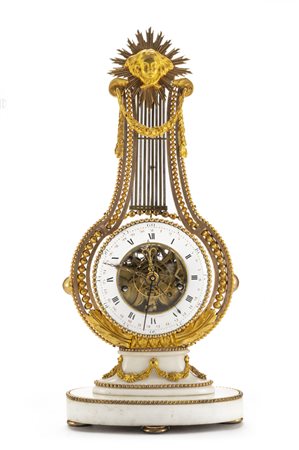 Lucas - Via Nino Bixio 32, 20129 Milano
Lucas - Via Nino Bixio 32, 20129 Milano
ARGENTI, DIPINTI, ICONE ED OGGETTI D'ARTE ARGENTI, DIPINTI, ICONE ED OGGETTI D'ARTE
lunedì 19 aprile 2021 ore 15:00 (UTC +01:00)
Furet, orologio da appoggio francese a lira scheletrato
Furet, importante orologio da appoggio francese a lira scheletrato, con pendolo a intera massa oscillante. Cassa in marmo bianco, con decorazioni in bronzo dorato al mercurio, di epoca Luigi XVI. Quadrante in smalto bianco ad anello, con calendario dei giorni del mese, attraverso il quale è visibile il movimento: il quadrante è firmato Furet à Paris. Il pendolo è sospeso superiormente, di tipo compensato ad aste multiple, con la lente ampia a C, a perle dorate, oscillante intorno al magnifico movimento a scheletro, visibile posteriormente attraverso la copertura a vetro a protezione. Scappamento del tipo di Amant, con grande àncora. Ultimo quarto del XVIII secolo.
Jean-Baptiste-André Furet (1720-1807), discendente da una famiglia di importanti orologiai, lavorò presso la bottega paterna a Parigi tra il 1746 ed il 1749, per poi intraprendere attività in proprio con indirizzo in Rue Saint Honoré. Nel 1783 fu nominato Horloger du Roi. La sua attività fu funestata da difficoltà economiche che lo condussero ad una tragica bancarotta nel 1786. Suoi orologi sono attualmente presenti nei principali musei, tra cui il Louvre, Waddesdon Manor, le Royal Collections britanniche, il Metropolitan Museum di New York ed il Patrimonio Nacional di Madrid.
Una pendola a lira di Furet, di tipo analogo a quella qui presentata, è stata venduta all’asta da Sotheby’s nel 2017
Furet, important French mantel clock in the shape of a lyre, with whole oscillating pendulum. The case is white marble, decorated with ormolu friezes of Louis XVI style. The dial is a white enamel ring, with days of the month calendar: the movement is visible through the hour chapter. The dial bears the signature Furet à Paris. The pendulum is compensated gridiron type and has a wide C bob, with golden beads, oscillating around the exquisitely skeletonized movement, visible through the glass back protection. The movement has an Amant-type escapement, with a large A-type anchor. Last quarter of the 18th century.
Jean-Baptiste-André Furet (1720-1807) came from a family of renowned clockmakers. He worked together with his father in Paris from 1746 to 1749, then he started his own business in Rue Saint-Honoré. In 1783 he was appointed Clockmaker to the King. His professional life was disrupted by financial problems, leading to bankruptcy in 1786. His clocks are in the most important museums, like the Louvre in Paris, at Waddesdon Manor, the Royal Collections in UK, the Metropolitan Museum of New York and in the Patrimonio Nacional of Madrid.
A lyre mantel clock by Furet, similar to the one presented here, was sold at auction by Sotheby’s in 2017
Altezza 48 cm




